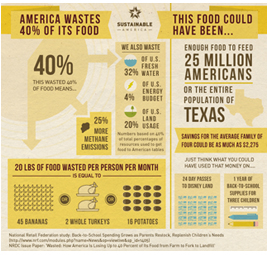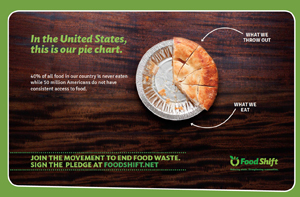Waste Diversion | Food Reduction
To shed light on waste diversion as a whole we’ve broken this BIG issue into two categories. One, waste diversion through “Food Reduction”, and two, waste diversion through “Compostable Waste Management”. Combating food reduction often gets lost in the waste diversion conversation. However, wasted food is having no issues finding its way to our landfills!
The Foodservice industry generates a staggering amount of solid waste. When you think about the fact that 8.5% of food purchased for production becomes waste even before it is served. Then you combine that with improper portioning, plate garnishing, and the occasional return you can add another 7% to the mix. This waste includes, food trimmings, post-consumer food scraps (plate scrapings), waxed cardboard, paper containers, plastic cutlery, Polystyrenes and napkins. This conglomeration of product is the single largest component of trash that fills our city dumps.
 Proper waste control and diversion provide an environmental benefit, and contribute to cost savings and profit. It is estimated that restaurants generate about 1 pound per seat, per day of solid waste. Of this waste, 37% is food. When food waste goes to a landfill its decomposition generates methane gas. Methane gas is a greenhouse gas with 21 times the negative impact to the environment compared to carbon dioxide. Additionally, another 14 percentage of greenhouse gases in the United States are associated with growing, manufacturing and transporting of food.
Proper waste control and diversion provide an environmental benefit, and contribute to cost savings and profit. It is estimated that restaurants generate about 1 pound per seat, per day of solid waste. Of this waste, 37% is food. When food waste goes to a landfill its decomposition generates methane gas. Methane gas is a greenhouse gas with 21 times the negative impact to the environment compared to carbon dioxide. Additionally, another 14 percentage of greenhouse gases in the United States are associated with growing, manufacturing and transporting of food.
Foodservice operators have multiple opportunities to deal with this situation, including purchasing, storing, preparing, serving, cleaning, donating, and disposing of food. Each step represents an opportunity to minimize food waste. With a continual focus on cost reduction and increasing interest in sustainability more aggressive waste diversion options can realize environmental benefits, cost savings as well as minimizing food waste. As we see it; we need to reduce the cost of food purchases, solid waste disposal, and increase food donations. The reduction of food purchases through more efficient buying practices minimizes food waste, in each step from purchasing through serving. This causes a reduction of disposal cost by minimizing waste. It reduces the environmental footprint by wasting less food and reducing the associated greenhouse emissions polluting our air and water, as well as reducing water use, and the landfill space it requires. This aggressive approach demonstrates an environmental commitment to the customers, community, and employees. Cutting food waste is a win, win, win! We can save money on the food we don’t waste, we could save enough food to potentially feed millions of hungry Americans, and we can also save the water & energy used to grow the food we waste.
So what are some reduction and prevention strategies?
Do an assessment of food waste – the first step to reducing food waste is to measure and track the amount, reason, and type of waste. Knowing how much and why will help you to assess target areas and design prevention strategies. This will be a baseline for you to measure the diversion rate and changes in spending.
- Reduce Food Waste in Kitchen- from your assessment data research the possibility of over purchasing. Evaluate your purchasing strategy. In many cases a “Just-In-Time” ordering system for highly perishable items may need to be implemented.
- Evaluate prep waste and improperly cooked foods-mistakes in the back of the house are a given but, consider implementing strategies for reducing waste through additional training. Assess knife skills, recipe sizing and adherence, portion control and proper cooking techniques.
 Design recipes with a secondary uses for excess- Leftover bread can become croutons, excess rice can become fried rice or pudding, leftover fruit can be cooked into a dessert topping, and clean vegetable trimmings can help form a base for soups, sauces, and stocks.
Design recipes with a secondary uses for excess- Leftover bread can become croutons, excess rice can become fried rice or pudding, leftover fruit can be cooked into a dessert topping, and clean vegetable trimmings can help form a base for soups, sauces, and stocks.- Properly organize and donate – Think before your dispose! There are several alternatives with each community to help feed those in need.
- Ensure proper storage techniques- all prepared items should be properly labeled with a born on date and an expiration date, ensuring that it is “first in an first-out” (FIFO) inventory program. This goes along with health inspection parameters
- Reduce Post-Consumption Plate Waste- – Post-Consumer waste includes all food product waste generated once the food reaches the customer. This includes food left uneaten and garnishes.
- Modify your menu to increase customer satisfaction and reduce foods left uneaten – Food frequently left uneaten or sent back by customers can be identified by tracking wasted food,. Based on this information, managers can modify the menu and better satisfy the customers.
- Change serving sizes and garnishes – Even small garnishes and improper serving sizes quickly add up to a significant amount of food waste. Strategies to reduce this waste include avoiding inedible or rarely eaten garnishes, reduce the scoop or serving size while still satisfying a customer’s appetite. Try using an “ask first” policy for sides.
- Encourage guests to order or take only the food they wish to consume – Food service managers can post informational signs at buffet-style foodservice venues that encourage customers to take only enough food to match their appetite. Servers can interact with the customer upon the initial order taking process..
- Go Tray less – A 2008 study of 25 college campuses conducted by the food services provider Aramark found that removing trays at dining halls results in as much as 25 to 30 percent less wasted food. Discourage customers from wasting food by going tray-less.
For additional Information check out the links and mentions below. There is tons of good info out there it just take time and commitment to make a difference.
Mintscrap.com : Solving the Problems of wasted food, with a simple app.
GNM Sustainable News | Waste Diversion
The U.S. Environmental Protection Agency has a free log book for tracking available (http://www.epa.gov/osw/conserve/materials/organics/pubs/food-waste-log.pdf). See attachment A.






